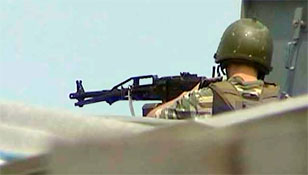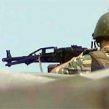
Disputed Border Area Between Chechnya and Ingushetia Remains Regional Hot Spot
Publication: Eurasia Daily Monitor Volume: 10 Issue: 53
By:

Another successful special operation by government forces in the border area between Chechnya and Ingushetia has again attracted attention to this region, which is sometimes referred to as a Bermuda triangle on a local scale. From examining the major armed incidents in Ingushetia over the past 1–2 years, one can conclude that the vast majority of them took place in this border area “hotspot” between the two North Caucasian republics. Since February 19, a counter-terrorism operation regime has been in place in this area (www.kavkaz-uzel.ru/articles/220330/).
The Russian media kept changing the number of people killed in the special operation, which took place two kilometers away from the village of Dattykh in Ingushetia’s Sunzha district. On March 16, various media sources reported that interior ministry and Federal Security Service (FSB) officers had located and surrounded a group of up to 15 militants in this area. In the armed clash that followed, five militants were reportedly killed when they tried to break out of the encirclement. Russian media initially reported that five rebels were killed (www.newsru.com/russia/16mar2013/bandits.html) and a little later, after 7 p.m., Moscow time, the media increased the number of slain rebels to seven (https://echo.msk.ru/news/1032790-echo.html).
The reports suggested that the special operation was ongoing, but it was unclear whether it was the same operation or a different one, since the militants appeared to have moved several kilometers to the south. According to government sources, in the afternoon on March 16, another group of rebels was detected in Chechnya’s Achkhoi Martan district, in the area of Gora Bozgenty, a mountain 16 kilometers away from the village of Bamut (www.kommersant.ru/news/2148467). The government forces allegedly had an armed encounter with the rebels, who fired back and retreated. The army followed up with shelling possible rebel locations for over an hour. In the fall of 2012, the Russian government officially approved using the army in special operations against militants in the North Caucasus (www.newsru.com/russia/08oct2012/army_2.html). Media reports said that government forces did not suffer any casualties in the latest operation.
It appeared that the government officials were playing with words. Both the village of Dattykh in Ingushetia and the Gora Bozgenty in Chechnya are practically the same location. This is the area where the Orstkhoi clan has traditionally resided. It would have been more appropriate for the government to report that Gora Bozgenty is 3–4 kilometers away from Dattykh rather than 16 kilometers away from Bamut. So this operation took place in the same area. This explains why five militants were initially reported dead: they most likely were covering the retreat of their commander and the main force of the rebel unit. The two rebels subsequently killed must have died in the shelling by army artillery. So there were not two special operations—just one that was only split by the Ingush-Chechen administrative border. On the Ingush side it was defined by the village of Dattykh and on the Chechen side it was defined by Gora Bozgenty. The small Martanka River formally divides Chechnya and Ingushetia in this area. Thus, the rebels’ version of the events—which asserted there had been no armed encounter between the rebels and government forces, but simply bombing and shelling of a rebel base that killed four rebels—has some credence (https://kavkazcenter.com/russ/content/2013/03/16/96828.shtml). According to rebel sources, artillery and jets bombarded the area on March 15 (www.kavkaz-uzel.ru/articles/221510/), while government special forces arrived at the site of the destroyed rebel base on March 16. This explains why the government forces did not suffer any casualties.
This symbolic Dattykh-Arshty-Bamut triangle is today the primary headache for the Chechen, Ingush and Russian security services. A large number of Chechen rebel groups are concentrated in this area, including the group led by the Achkhoi-Martan district’s Emir Abu-Muslim. Militants led by Emir Khamzat, the first deputy to the leader of the North Caucasian rebels, Doku Umarov, are also located there. Also found in this area are the emir of the Chechen part of Sunzha district, Abdusabur, along with his men, as well as the emir of the Ingush part of Sunzha district and the emirs Zumso and Mukhadis and their people. In addition, it should not be forgotten that Umarov himself is also located in this region. So, there may be a total of 100 Chechen militants or more located in this area.
Thus, it is not surprising that nine out of ten of the special operations by government forces in the region are conducted in this area. Perhaps most striking was the fact that neither the Ingush nor Chechen government claimed success in this special operation: indeed, the FSB and Russian Ministry of the Interior took full credit for it. The information about the operation came from the Russian National Anti-Terrorist Committee in Moscow. Given that the leaders of Chechnya and Ingushetia are embroiled in a territorial dispute, either of them could have claimed taking part in the killing of rebels, but they did not. If it is not a coincidence, it may reflect a new policy of Moscow in the region designed to relieve tensions between the two republics. At this point, it is still hard to say whether Moscow finally became involved in the border dispute between Ramzan Kadyrov and Yunus-Bek Yevkurov—the leaders of Chechnya and Ingushetia, respectively.
Special operations have been continually conducted in this area over the past 13 years, and it remains a highly volatile territory that is the source of many problems for the republics of Chechnya and Ingushetia. It was the concentration of rebels in this area that became a contentious issue between the two republics. Scant evidence suggests the situation in this area will clear up soon, so for the foreseeable future one will likely to hear more reports of special operations being conducted in this North Caucasus hotspot.




